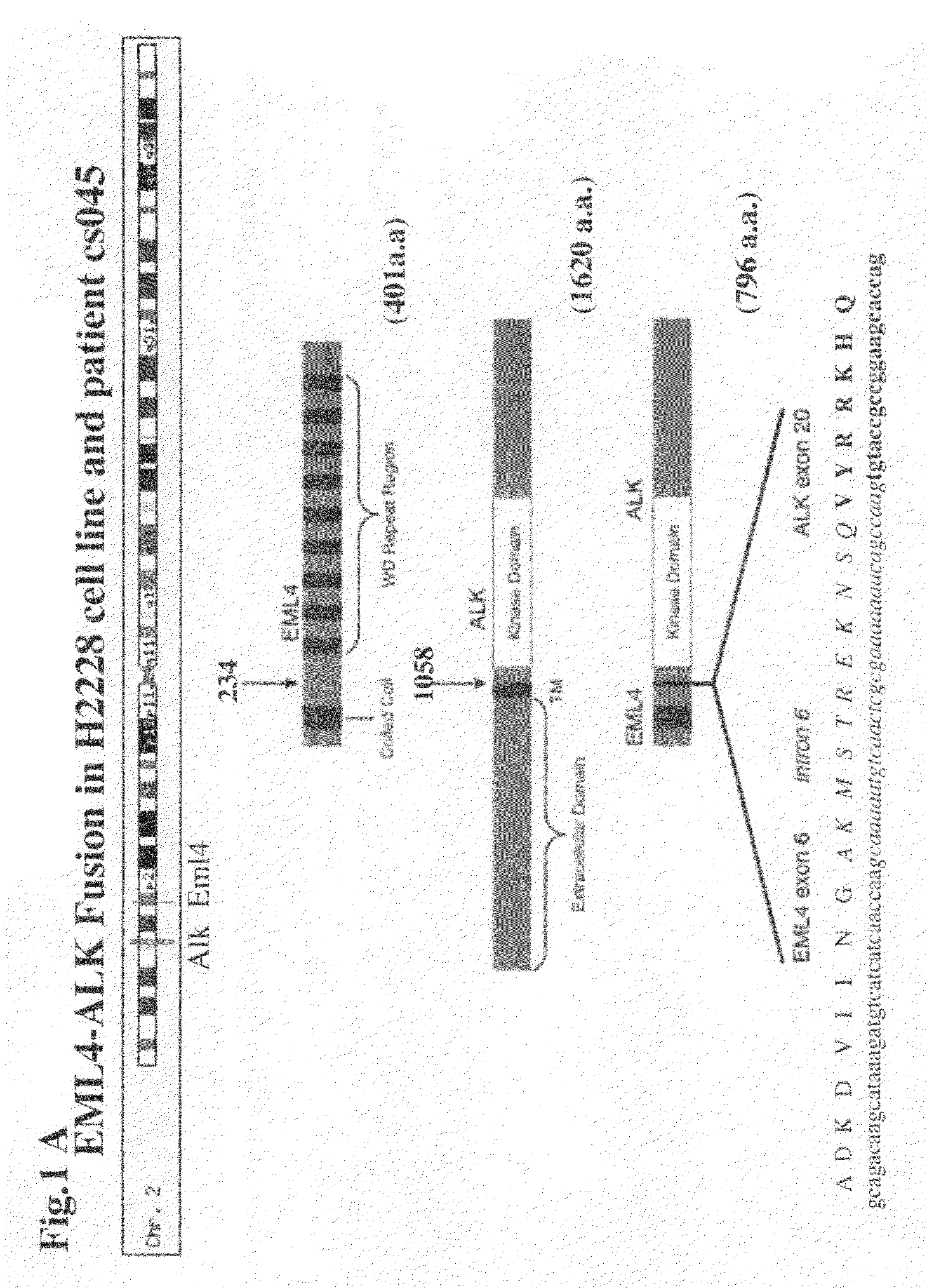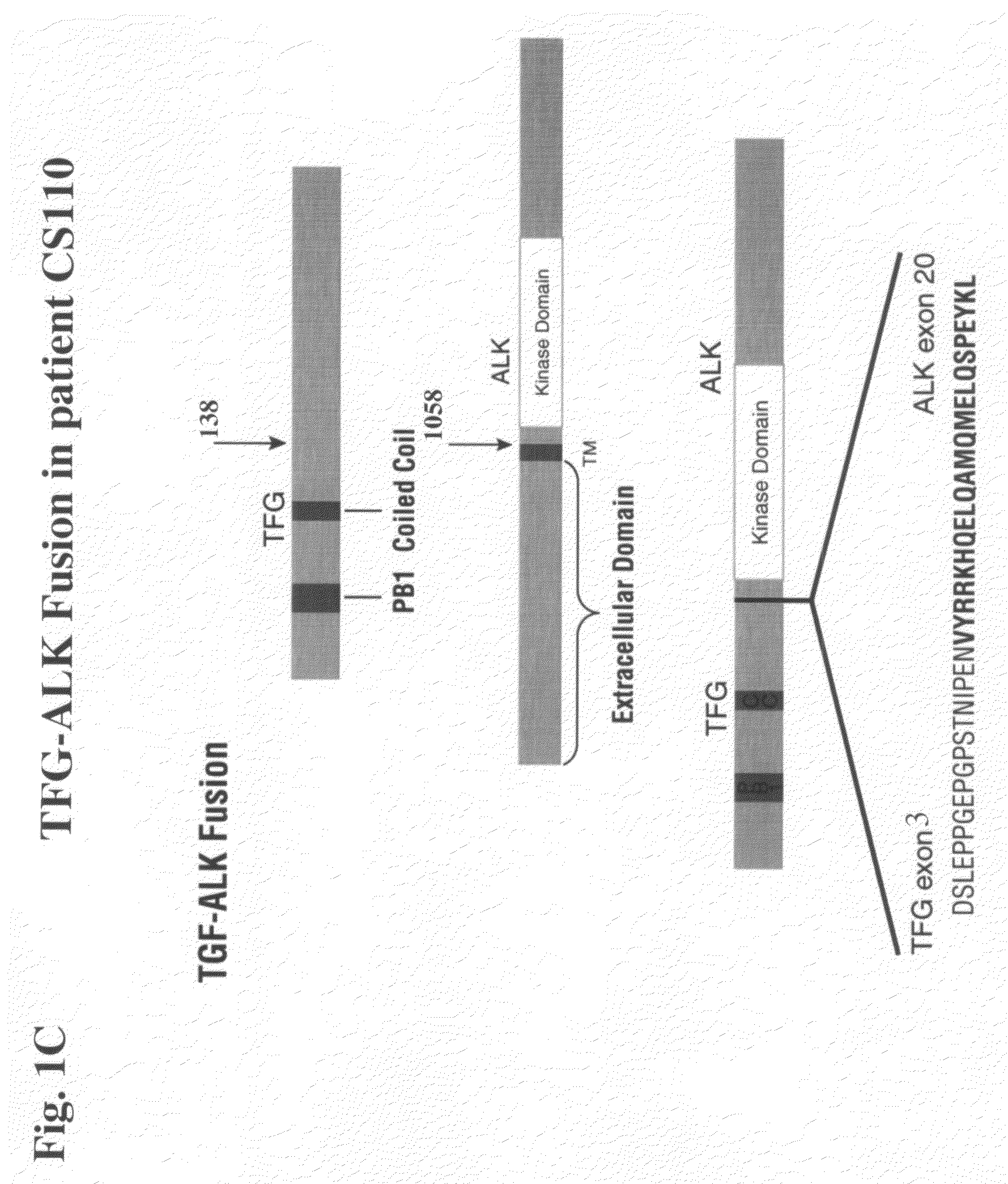Gene defects and mutant ALK kinase in human solid tumors
a technology of mutant alk kinase and human solid tumor, which is applied in the field of protein and gene involved in cancer, can solve the problems of uncontrolled growth and proliferation of cells, no translocation or deletion of human nsclc, and aberrant control of cellular processes
- Summary
- Abstract
- Description
- Claims
- Application Information
AI Technical Summary
Benefits of technology
Problems solved by technology
Method used
Image
Examples
example 1
Identification of ALK Kinase Activity in Solid Tumors by Global Phosphopeptide Profiling
A. Profiling of Human NSCLC Cell Lines.
[0269]The global phosphorylation profile of kinase activation in 22 human NSCLC cell lines, including H2228, were examined using a recently described and powerful technique for the isolation and mass spectrometric characterization of modified peptides from complex mixtures (the “IAP” technique, see Rush et al., supra). The IAP technique was performed using a phosphotyrosine-specific antibody (CELL SIGNALING TECHNOLOGY, INC., Beverly, Mass., 2003 / 04 Cat. #9411) to isolate, and subsequently characterize, phosphotyrosine-containing peptides from extracts of the NSCLC cell lines.
[0270]Specifically, the IAP approach was employed go facilitate the identification of tyrosine kinases responsible for protein phosphorylation in each of the NSCLC cell lines. In particular, atypical or unusual kinase activity was considered.
Cell Culture.
[0271]All cell culture reagents w...
example 2
Isolation & Sequencing of Three ALK Fusion Genes
A. Sequencing in Human NSCLC Cell Line.
[0289]Given the high phosphorylation level of ALK kinase detected in the NSCLC cell line H2228, 5′ rapid amplification of cDNA ends on the sequence encoding the kinase domain of ALK was conducted in order to determine whether a chimeric ALK transcript was present.
Rapid Amplification of Complementary DNA Ends
[0290]RNeasy Mini Kit (Qiagen) was used to extract RNA from the H2228 cell line. DNA was extracted with the use of DNeasy Tissue Kit (Qiagen). Rapid amplification of cDNA ends was performed with the use of 5′ RACE system (Invitrogen) with primers ALK-GSP1 for cDNA synthesis and ALK-GSP2 and ALK-GSP3 for a nested PCR reaction.
5′ RACE
[0291]FIG. 5 (panel A) shows the detection of the EML4-ALK fusion gene (short variant) by 5′RACE and the detection of the PCR amplification product after 2 rounds. The PCR product was purified with PCR purification kit (Qiagen) and sequenced using ALK-GSP3 an ABI 313...
example 3
Growth Inhibition of ALK Fusion-Expressing Mammalian Solid Tumors Using siRNA
[0302]In order to confirm that the truncated / fusion forms of ALK are driving cell growth and survival in NSCLC cell line H2228 as well as NSCLC tumor samples from patients CS010 / 11, CS045, and CS110, the ability of siRNA (against ALK) to inhibit growth of these cells and tumors may be examined.
[0303]ALK SMARTpool siRNA duplexes (proprietary target sequences—data not shown) may be purchased, for example, from Dharmacon Research, Inc. (Lafayette, Colo.). A non-specific SMARTpool siRNA is used as a control. Cells are transfected with the siRNA via electroporation. Briefly, 2×107 cells (H2228) are pulsed once (20 ms; 275V, K562 20 ms; 285V) using a square-wave electroporator (BTX Genetronics, San Diego, Calif.), incubated at room temperature for 30 minutes and transferred to T150 flasks with 30 ml RPMI-1640 / 10% FBS.
[0304]The number of viable cells is determined with the CellTiter 96 AQueous One solution cell pr...
PUM
| Property | Measurement | Unit |
|---|---|---|
| Tm | aaaaa | aaaaa |
| Tm | aaaaa | aaaaa |
| Tm | aaaaa | aaaaa |
Abstract
Description
Claims
Application Information
 Login to View More
Login to View More - R&D
- Intellectual Property
- Life Sciences
- Materials
- Tech Scout
- Unparalleled Data Quality
- Higher Quality Content
- 60% Fewer Hallucinations
Browse by: Latest US Patents, China's latest patents, Technical Efficacy Thesaurus, Application Domain, Technology Topic, Popular Technical Reports.
© 2025 PatSnap. All rights reserved.Legal|Privacy policy|Modern Slavery Act Transparency Statement|Sitemap|About US| Contact US: help@patsnap.com



